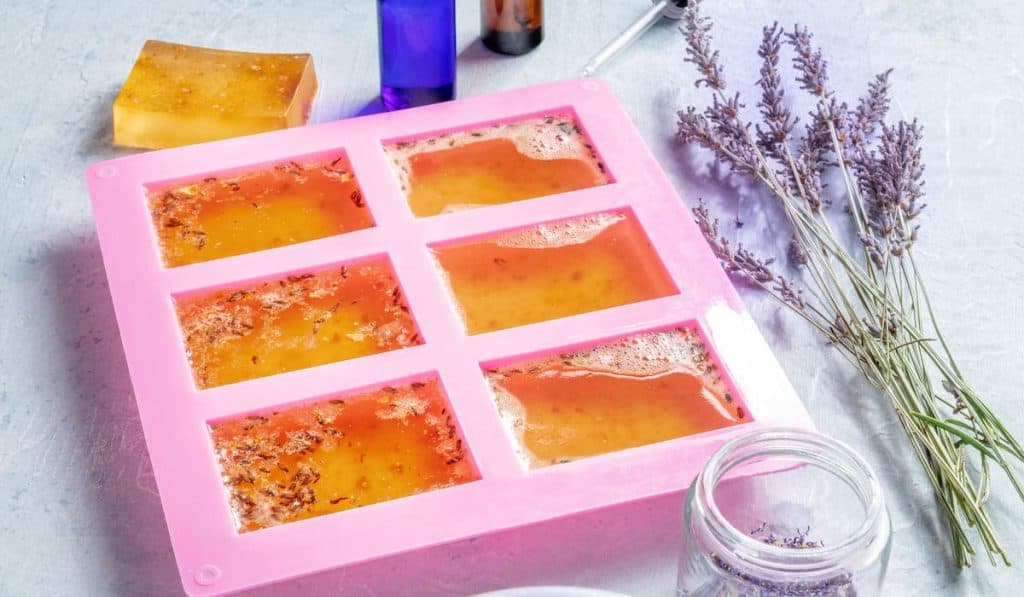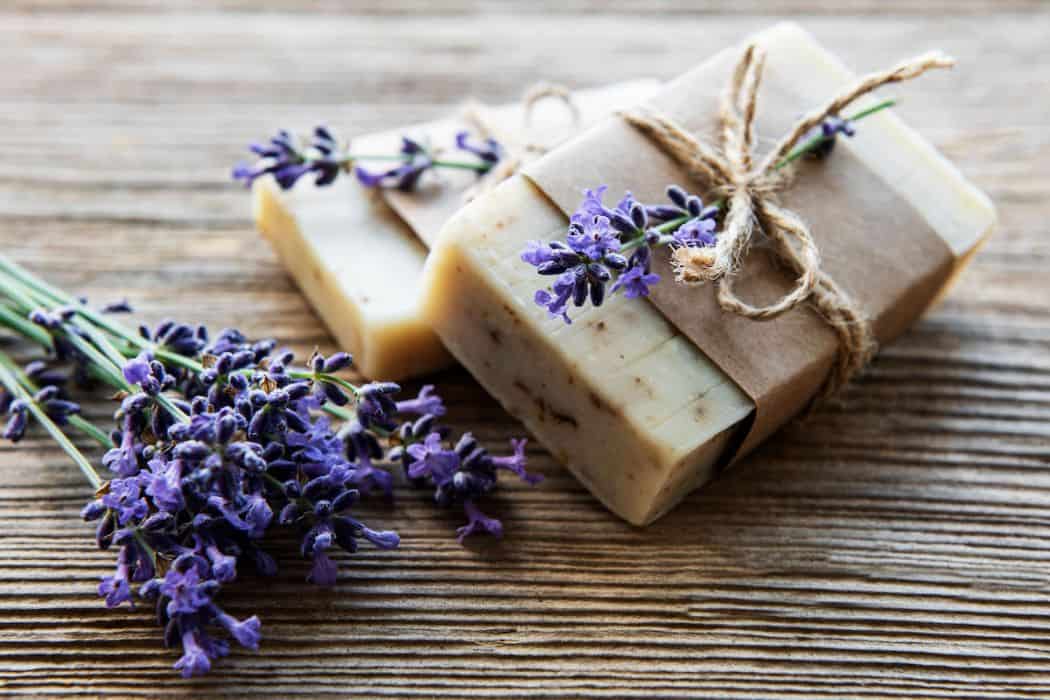There are a couple of ways that you can go about making homemade soap. These are cold process and melt and pour. While both soaps can be of great quality, cold press soaps tend to have ingredients and fragrances that are more skin-healthy and natural.
It all depends on how you make the soap, however!
Let’s have a look at some soap making kits that make a great option if you’re just learning the hobby.
Good Online Seller
- ADORE THE REFRESHING SCENTS : of vanilla hazelnut, lavender, cherry blossom, and grapefruit mint. Make your own soap at home to enjoy the benefits of fragrance oils and scents while spending time with your family doing arts and crafts.
- SOAP MAKING SUPPLIES : includes 2 melt and pour shea butter soap base (2 lb), 4 fragrance oils, 4 liquid dyes (blue, yellow, green, red), 2 plastic soap molds, 1 mixing bowl, 2 strring sticks, 4 gift boxes and instruction manual.
Beginner Friendly Kit
- 🧼COMPLETE STARTER SET – Everything you need to create your own homemade soap is in this package. The package includes 2 lbs shea butter soap base, 2 silicone square containers, 6 liquid dyes, a glass measuring cup, a silicone stirring stick, 2 dry flowers, 12 homemade wraps labels tape a very detailed introduction.
- 🧼HOW SOAP WORKS – Soap contains fat-like substances known as amphiphiles, the soap molecules “compete” with the lipids. This is more or less how soap also removes normal dirt from the skin.
- 🧼CREAT YOURSELF – People that enjoy crafting and would like to make soaps that are more fun and creative than the typical bar will enjoy this method of soaping. Not only can you combine any scent with any color, but you can create crazy fun designs that are not often found in soaps.
Editors Pick
- ALL THE SOAPMAKING SUPPLIES YOU NEED IN ONE KIT – Use our easy instructions to pour up to 8 bars of soap at a time using the included decorative molds, pipette, essential oils, and colorants
- 3 LBS ORGANIC GLYCERIN SOAP BASE for making up to 16 bars of soap at home Vegan, soy-free, hypoallergenic, gluten-free, kosher and non-comedogenic, this moisturizing soap base is great for all skin types!
- 3 ESSENTIAL OILS for natural fragrance: lavender, blood orange, and cedar, mix and match to create your own blends & 3 COLORANTS that can be combined to create a multitude of shades
Lovely Gift Set
- ♥ ALL THE SOAPMAKING SUPPLIES YOU NEED IN ONE KIT – Use our easy instructions to melt and pour soap base into the embossed soap molds in this easy soap making starter kit. Personalize each bar using 3 liquid dyes to tint your soap, 3 all natural essential oils, and included dried bonus flowers. A great DIY item for craft fairs and fundraisers, your audience will be sure to be impressed with these artisan bars of soap.
- ♥ 3 LBS COCOA BUTTER SOAP BASE – Crafts up to 16 unique soap bars. Our soap bases are made in the USA using only the finest ingredients. Kosher vegetable glycerine and food grade oils make these luxurious soap bars excellent for sensitive skin. They are made of soy-free, Non GMO components, and as our supplier puts it “As natural as we can make it.”
Junior Gift Set
- Soap Making Kits For Beginner Kids: Dazzle your daughter today with an exciting soap making kit for girls and boys. The B Me make your own soap kit for kids will help your little one unleash her imagination and creativity.
- Science Kits for Girls: The reusable silicone mold tray and 30 soap cubes will allow your girl to make a stem project and create up to 15 + fun-shaped soaps, layered soaps or encapsulated soaps with just one craft kit. – Make even more by using the smaller molds
- Perfect Slumber Party Activity: If you are looking for an engaging and educational sleepover, playdate, slumber birthday party game for girls, look no further than the B Me DIY soap making kit.
Buyers Guide
Types of Soap Making
Cold-Process Soap
Cold process soap is the more complicated of the two methods, as you’ll be working with lye and adding a lot more ingredients, pretty much making the soap from scratch. Specifically, cold process soap is made with a combination of lye, and oil.
This causes a natural reaction called saponification, which causes the soap to harden. Not only that, but it neutralizes the lye over time, leaving only its antibacterial properties and rendering it gentler.
To make cold process soap, you’ll need lye, water, and various types of moisturizing and nourishing oil. The best oils to comprise the majority of your soap are olive oil and coconut oil. Other excellent additions are shea butter, palm oil, almond oil, safflower oil, avocado oil, and beeswax!
First, make up your lye (lye combined with water, as directed on the container). Then, melt your oil at no more than 120-130 F. Let the oil cool a bit, and the lye cool to within 10 degrees of the same temperature (110-140). At this point, they’re ready to be mixed together!
Once your lye and oils are combined, you’ll want to be prompt about adding fragrance and color. The soap will thicken as it begins to cool. Once you’re done, pour the soap into the mold or molds, and allow it to harden and cool. Cold-press soap will need to cure for 2-4 weeks, roughly.
Melt and Pour Soap

Compared to cold process soap, melt and pour soap is much simpler. Whereas you need to gather and purchase ingredients separately with cold process, melt and pour soap comes in a ready-to-go block. This is typically composed of glycerin or shea butter.
With melt and pour soap, all that you need are a mold, some soap-safe fragrances, and some dyes or powders. Melt the soap, color it, add your scent, and pour. Unlike cold process soap, melt and pour soap does not need to cure and can be used as soon as it’s been allowed to cool (overnight).
What is a Soap Making Kit?
A soap-making kit is a package containing the most important supplies that you need to make soap. This means a base, fragrances, and molds. Some also come with dyes or powders and a handy pitcher. They can make the sometimes-complicated process of soap-making much easier.
All of the ingredients you need will be in one place, without the need to rummage them up or purchase them separately. It’s a cost-effective and convenient option, and perfect if you’re short on time or funds but want to make some really nice soap to gift, sell, and enjoy yourself.
What to Look For in a Soap Making Kit
Of course, not all soap-making kits are going to be the same quality. Some will cut corners, using fragrances containing chemicals, etc. So, what should you look for in a soap-making kit?
A Quality Base
The most important part of your soap is the base. You can have the loveliest fragrances in the world, but a poor base will spoil its texture and lather. Many soap-making kits have a glycerin base, which can make an average to good-quality soap. To make truly great soap, you’ll want to go with a soap base made from something super skin-healthy and moisturizing, like shea butter.
If you’re making cold process soap, you can look for kits that contain only the molds, fragrance, and color. Either way, you’ll have a much simpler task!
Chemical-Free Dye or Powder
While a base is the most important, you still wouldn’t want to degrade it with a low-quality dye or powder. These can have harsh chemicals, which will irritate the skin. Some may not even be non-comedogenic, meaning that they will clog your pores (causing breakouts).
Instead, look for gentle, soap-safe dyes and powders. Any soap-making kit worth its salt should have decent-quality dyes and powders. Look at its reviews to double-check!
Natural Fragrances
Have you ever smelled a soap that was just a bit unpleasant? Maybe the chemical smell was too strong, the floral scent pungent and unnatural. Or worse, has soap caused your skin to itch or dry out?
No one wants soap that smells funky, or that will irritate their skin, so it’s important that the fragrances in the kit you choose are all-natural. They should be made up not of chemicals, but of essential oils, plant resins, etc.
These will be much more refreshing scents, and they rarely cause skin irritation (some individuals may still experience allergies, so use care).
A Mold

Next, you’ll need a large mold or several small molds for your sudsy brew. There are molds in just about every shape imaginable, but to start, you might want to begin with your classic cut-block bar. Basically, you make one very long soap block, from which you cut eat individual bar. Whatever suits your fancy, however!
Want to learn more about soap making? Then read our complete guide here!
A Pitcher
Before you can get your melted soap into the molds, you’ll need a pitcher. This will allow you to pour with precision, ensuring that no hot soap spills out of the container. It’s important for both safety and convenience to have a proper pitcher that’s nice and heat-proof.
What Other Supplies Do You Need?
- A stirring utensil. With cold processed soap, once your oils have melted, you’ll need a utensil for stirring them together. This will also be needed when you are mixing in fragrances and colors. So, it is also a necessity for melt and pour soap making. A big spoon or spatula will do the trick!
- A lye-proof (and heat-proof) stirring utensil. If you are making cold processed soap, you will need a heat-proof stirring utensil to combine the lye and the water. The most effective is a whisk.
- A cutting board. If you are making your classic block-cut soaps, you’ll need a cutting board to spare your table or counter!
- A microwave-safe bowl. If you’re making melt and pour soap, you’ll need a microwave-safe bowl to melt your base (cold process soap oils, on the other hand, are most often melted in a pot).
- A lye-safe (and heat safe) bowl. You will need a nice, lye-safe (and heat-safe, because lye heats up when it touches water) bowl for when you combine your lye and water. Glass is especially lye-proof.
- A sharp knife or soap cutter. If you like, you can cut your soaps out of a block with a sharp knife. Soap is not much more difficult to chop than butter. That being said, you can also streamline the process and make sure all of the bars are perfectly uniform with a soap cutter!





